Top News
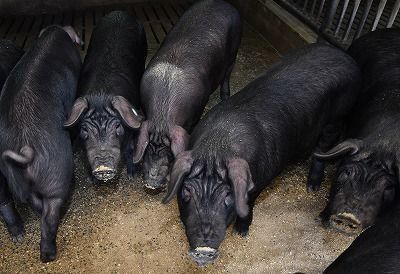
October 11, 2018 Ryukyu Shimpo
The Okinawa Prefectural Livestock Research Center in Nakijin carried out research on the meat quality of Agu brand pigs, and found that Agu pork contains more components that affect the deliciousness of the meat than western pork.
Compared with average pork, Agu pork contained about 1.38 times the free amino acids, which affect umami and sweetness.
In addition, Agu pork is excellent at retaining water, so the amount of meat juice lost when cooking is less than that of average pork.
Until now there have been few scientific research findings that demonstrate the deliciousness of Agu pork.
The results are expected to enhance the exposure and value of the brand.
Agu brand pigs are bred from Agu male pigs and Western or other female pigs.
The meat quality study examined the loin portion of ten ordinary pigs and ten Agu brand swine.
Agu pigs contained 78.9 milligrams of free amino acids in a 100-gram sample, while ordinary pigs contained 57 milligrams.
Also, cooking loss of meat juice was lower and pressed juice percentage in cooked meat was higher in Agu pigs.
Producers and distributors requested explanation of the meat quality characteristics.
Katsuhiro Shimajiri, director of the Agriculture, Forestry and Fisheries Department of the Okinawa Prefectural Government, said, “I can attest to the good quality of the Okinawa Agu pigs on scientific grounds.
If the production system is set, the potential [to sell] overseas will also expand.”
According to a survey by the Okinawa Agu Brand Pork Promotion Council, the number of Agu shipments in FY2017 was 30,5093, marking an increase of bout 2,000 from four years prior.
(English translation by T&CT and Megumi Chibana)
Go to Japanese
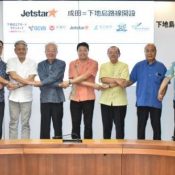
October 16, 2018 Ryukyu Shimpo
Okinawa Prefecture, who along with Mitsubishi Estate Co., Ltd. and Miyakojima City have been working to renovate the passenger terminal facilities at Shimoji-shima Airport, held a press conference October 15 at the Okinawa Prefectural Office, where they announced that the terminal will open March 30, 2019.
Jetstar Japan has also announced their decision to have a scheduled flight from Narita Airport to Shimoji-shima Airport one a day starting next spring.
There is also a plan to eventually increase flights to both the Kyushu and Kansai regions.
There is also work done to realize international routes to places such as Taiwan, Hong Kong, and Korea as well as chartered flights, and the hope is to establish these routes by opening day.
The goal is to establish three domestic and three international routes.
They are also planning on making it possible for private jets to use the airport.
Jetstar will fly a 180-passenger capacity Airbus A320 out of the reopened airport.
The goal for the terminal is to make it capable of servicing 110,000 people in 2019, and increase that to 570,000 people per year by 2025.
Miyakojima only has 1,000 rooms of tourist accommodations, but plan to increase that number by 3,300 rooms in 2019.
The facilities employ 10 people currently, and will hire 20 people locally by the opening next year.
Miyakojima Deputy Mayor Seiji Nagahama said, “The city is also increasing its cruise ship capacity, so we are increasing the number of people we are bringing to the island by both air and sea. This is a big chance for us.”
(English translation by T&CT and Sam Grieb)
Go to Japanese

October 10, 2018 Ryukyu Shimpo
An Okinawa prefectural funeral ceremony for former governor Takeshi Onaga was held on the evening of October 9 at the Okinawa Prefectural Budokan in Naha City.
Onaga, age 67 when he died, demanded that Japan find solutions to the U.S. military base issues in Okinawa, and pursued promotional policies to improve welfare and other aspects of life in Okinawa.
The committee for organizing the funeral was composed of 8 organs including the Okinawa Prefectural Government (OPG), the Prefectural Assembly, the Okinawa Association of City Mayors, the Okinawa Association of Town and Village Mayors, and the Council of Okinawa Prefectural Economic Organizations.
Organizers announced that 3,000 people attended the ceremony.
It was a bitter and sudden parting with Onaga, who died in office in August while persisting in his public committment to stop construction of the Futenma replacement facility in Henoko, Nago City.
Governor Denny Tamaki, who acted as head of the committee organizing the funeral, gave a ceremonial address.
He said that Okinawans will carry through with Takeshi Onaga’s dying wishes, and pledged they would do so peacefully and with great dignity.
Chief Cabinet Secretary Yoshihide Suga attended the funeral ceremony and delivered a condolence message from Prime Minister Shinzo Abe.
Suga touched on the political stance of Onaga, who called on Japan to address the overlarge share of the base burden on Okinawa.
The chief cabinet secretary said, “The Japanese government, too, is taking steps to reduce the base burden.”
Suga has been advancing construction of the Futenma replacement facility in Henoko, and conflicted with Onaga’s administration over such.
During Suga’s address attendees scoffed at him and made noise.
The Prefectural Budokan Arena is equipped with 2400 seats for general attendance.
Even so, the attendees could not fit into the seating and overflowed into temporary viewing tents with monitors showing the ceremony.
During the funeral, former governor Onaga’s wife Mikiko and eldest son Yuichiro carried Onaga’s portrait and ashes onto the stage, led by Governor Tamaki.
All attendees joined together in a silent prayer for the deceased.
Naha Mayor Mikiko Shiroma, head of the Council of Okinawa Prefectural Economic Organizations Denichiro Ishimine, and a colleague representing Chairman Morimasa Goya of Kanehide Holdings also offered condolence messages.
Onaga is the fourth successive governor to receive an Okinawa prefectural funeral ceremony after Chobyo Yara, Junji Nishime, and Masahide Ota.
(English translation by T&CT and Erin Jones)
Go to Japanese

October 12, 2018 Ryukyu Shimpo
On October 11, a giant plant sculpture over 6 meters tall luxuriously using about 8,300 Strelitzia flowers, known for its distinctive orange and blue, appeared on Hyakuna Beach in Tamagusuku, Nanjyo City on the southern part of the main island of Okinawa.
A successful flower artist in and outside of the country, Makoto Azuma created the sculpture. The plan was to complete the sculpture by around noon on October 12.
Followed by cutting the flowers into pieces and distributing them to Hyakuna Beach visitors around 3 p.m. the same day.
Offering A Way of Enjoying the Flower
Azuma has managed flower shops since 2002 and currently manages a flower shop in Minamiaoyama, Toyko. Beginning around 2005, in addition to running a flower shop, he began taking part in artistic expression using plants.
Okinawa Prefecture is the number one producer of Strelitzia flowers in Japan.
However, the Strelitzia flower is not well known even by Okinawan citizens.
When rephrased as “Gokurakuchoka (Elysium bird flower),” the reality is that people unfortunately think of them as flowers for a household Buddhist altar before anything else.
Though this grand creation, Azuma hopes to offer a new way of enjoying the flower.
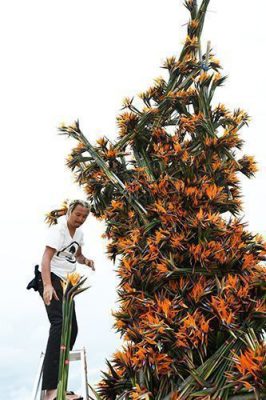
Makoto Azuma working on the plant sculpture using fresh flowers from Okinawa in the afternoon of October 11 at Hyakuna Beach in Tamagusuku, Nanjyo City (taken by John Matsumoto)
Regarding his motivation for this creation, he said, “(Strelitzia flowers) are dynamic and fascinating flowers.
Through this work of art, I hope people are able to enjoy them with a new perspective.”
On the first day on October 11, Azuma continuously worked on the sculpture between 9:30 a.m. to past 6 p.m. without taking decent meals.
He used up about 8,300 Strelitzia flowers and assembled the general framework of the sculpture.
The plan was to finalize it starting the morning of October 12.
After adding an additional 700 or so red lobster-claw flowers, it was to be completed around noon.
Since the sculpture would be taken part by the afternoon, people could only look at the completed sculpture for a limited amount of time.
Azuma reiterated the significance of the creation as he said, “As long as it remains in peoples’ memory after receiving the cut flowers that are handed out.”
Adding One Flower at a Time During High Tide
About 8,300 Strelitzia flowers were arranged on the beach, then Azuma and the production members worked together to complete the creation by adding one flower at a time.
Strelitzia flowers were inserted from various angles to a metal-piped frame.
The staff occasionally looked at the creation from a distance to check the shape as to “not ruin the outline and to listen to the voice of the flowers.
” The staff were seemingly trying to “become one with the flowers.”
In the evening, the tide creeped into the work area, causing waves to surround the scaffolding.
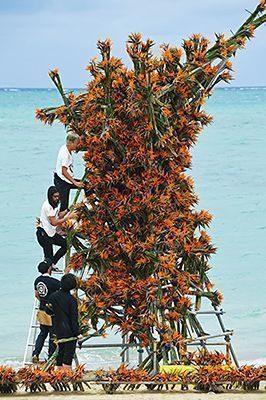
Project members working on the plant sculpture using fresh flowers from Okinawa in the afternoon of October 11 at Hyakuna Beach in Tamagusuku, Nanjyo City (taken by John Matsumoto)
Being exposed to strong beach winds and getting their feet wet helped actualize the image of the sculpture in the staff’s minds.
Ardent Eyes and the Wishes of Those Who Grow Strelitzia
Around 2 p.m. on October 11, about 25 members who grow Strelitzia came to observe the creation.
These members are from the JA Okinawa Tsukazan Branch Flower Plants Growing Subcommittee.
An order of 8,300 Strelitzia all at once was an order so large that even the JA executive said, “It’s unheard of.” The subcommittee Chairman Yukio Kamizato watched the Strelitzia flowers shipped from his own farm turn into a magnificent creation.
He smiled as he said, “I’m happy an artist turned Strelitzia flowers into art like this.”
Between the end of September and beginning October, there were two typhoons that hit Okinawa, damaging the flower plants within Okinawa. Subcommittee members worked together to gather those Strelitzia that “survived” those typhoons.
One of the Greatest Producers, Yet Not Known Well Enough?
With Okinawa’s warm climate, growing flower plants flourishes primarily around periods where production decreases at growing centers outside of Okinawa. This period is called “between-crops season.”
Shipment periods are adjusted via greenhouses and artificial light cultivation to systematically grow them.
For the New Years and equinoctial week, groups arrange for additional flights to help with shipments.
So much so that Okinawa produces 90% of all small chrysanthemums in the country during equinoctial week.

Makoto Azuma (top right) working on the plant sculpture using fresh flowers from Okinawa in the afternoon of October 11 at Hyakuna Beach in Tamagusuku, Nanjyo City (taken by John Matsumoto)
However, this is not known by many Okinawan citizens.
A representative of JA said, “Even during Governor Onaga’s funeral open to the citizens, there were many flowers from Okinawa on the altar.
But there weren’t many who paid attention to them.”
Okinawa may be the number one producer of Strelitzia in Japan.
But as the representative spoke on behalf of the those who grow the flower said, “Even if a person says their job is ‘growing Strelitzia,’ people have a hard time understanding that because it is not very well known.
At the same time, it conjures an image of flowers for household Buddhist altars, so you don’t get a good response even when you tell them wha
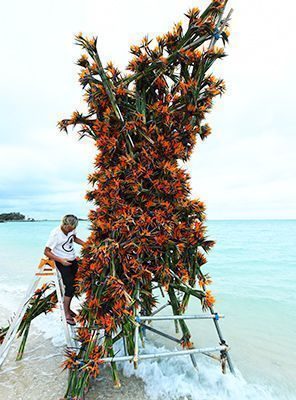
Makoto Azuma working on the plant sculpture using fresh flowers from Okinawa in the afternoon of October 11 at Hyakuna Beach in Tamagusuku, Nanjyo City (taken by John Matsumoto)
t it is.”
Strelitzia, also called “Gokurakuchoka (Elysium bird flower),” is called “bird of paradise flower” in English. Those who grow them emphasize the
brightness of the flower.
One person said, “I’d like people to use them in a wide variety of scenes and not just during ceremonial occasi
ons.
They’re pretty even when you put them in a vase by themselves.
Sometimes we even give (out of spec flowers) to relatives.”
The representative of JA said, “The flower is still not known by many and there aren’t enough successors.
There is a sense of danger that the flower itself may disappear (from a lack of interest).”
The representative also added, “I want locals to see this Strelitzia creation and to learn about a flower that is familiar to Okinawa.”
As a Person Who Expresses Himself Through Flowers
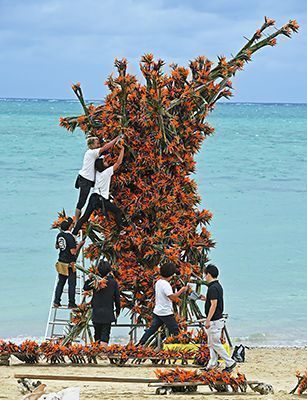
Makoto Azuma (top left) and project members working on the plant sculpture using fresh flowers from Okinawa in the afternoon of October 11 at Hyakuna Beach in Tamagusuku, Nanjyo City (taken by John Matsumoto)
On October 11, Azuama who worked on the sculpture for several hours said with a fulfilled smile, “There aren’t many opportunities to arrange eight-thousand Strelitzia flowers, so it’s a luxurious experience. As a person who expresses himself through flowers, I wanted to experience something I had never experienced before.”
Up until now, Azuma has created a flower sculpture using flowers purchased at a Thai market and created a piece made from sunflowers at a salt lake 3,500 meters above sea level.
Azuma spoke of the allure and said, “As you arrange local flowers around the world, it’s interesting because it changes the way we capture flowers.” Azuma plans to record the Strelitzia sculpture via footage and photos and plans to exhibit them during the modern art event that is to be held in Argentina in 2019.
(English translation by T&CT and Chelsea Ashimine)
Go to Japanese
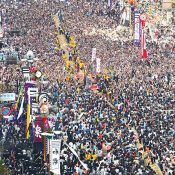
October 8, 2018 Ryukyu Shimpo
The 48th annual Naha Giant Tug-of-War took place at the Kumoji intersection on Route 58 on October 7. The event, organized by the Office of the Conservation Society of the Naha Giant Tug-of-War, lead to streets that brimmed with excitement from locals and tourists alike.
Participants split into two teams: East and West, with 15,000 attendees on each side.
The intense competition commenced at approximately 4:30 p.m., lasting 12 minutes while the crowd shouted, “Pull, pull!” The East team claimed victory after successfully bringing the rope five meters in their direction, making it their 16th win, with 14 losses and 15 draws to date.
The Kumoji intersection was bursting with the energy of some 270,000 spectators according to the organizers, and the spirited competition involved a 200-meter, 40-metric ton rope.
The East team claimed victory just as the previous year, having made great headway early in the game.
The West side momentarily resisted, but the score was settled in 12 minutes.
The crowd subsequently came together to dance the kachashi, a festive Okinawan folk dance.
The mood was jubilant, with plenty of smiles to go around among the families and tourists visiting from mainland Japan and abroad.
Koji Arai, 63, joined the West team with his family of three.
“I enjoyed myself so much I lost my voice. I liked the sense of unity,” he said with apparent satisfaction.
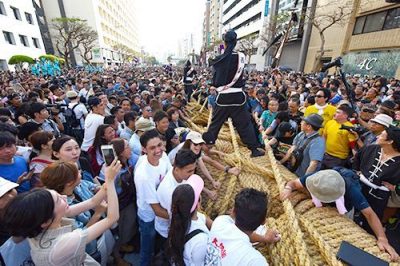
People chant and pull on the giant rope during the Naha Giant Tug-of-War on Route 58 at Kumoji, Naha City, on the evening of October 7. Photograph by Toyomi Takihata.
The main tug-of-war event was preceded by performances by karate artists, the splitting of an ornamental paper ball filled with confetti and a parade led by a flag bearer on Kokusai street.
Misaki Tanahara, 22, is a Urasoe local who attended the event with her friend. Although “there were so many people that we weren’t able to tug on the ropes,” she had a great experience, adding that “it was my first time and I had a lot of fun.”
The Naha Giant Tug-of-War is said to have first started around 1450, during the Ryukyu Kingdom era.
The tradition was abolished in 1935, but brought back in 1971. In 1995, the event was recorded in the Guinness Book of World Records as the largest tug-of-war event in the world.
(English translation by T&CT and Monica Shingaki)
Go to Japanese

October 4, 2018 Ryukyu Shimpo
By Ami Chibana
Manabu Kochi, 64, a painter and sculptor from Naha who currently lives in France, will have 45 of his works displayed at the Arab World Institute (AWI) Art Museum in Paris.
Kochi has previously had his works exhibited in city museums throughout France, but this will be the first time they will be on display and preserved at one of France’s designated national museums.
Kochi said happily, “I am proud as both a Japanese and an Okinawan to have my art on display at national museums in other countries.”
The AWI collects and exhibits artworks from the Arab world.
The Galerie Claude Lemand, which is run by Claude Lemand and has Kochi under contract, will be donating 1,300 pieces to the AWI, among which Kochi’s works are included.
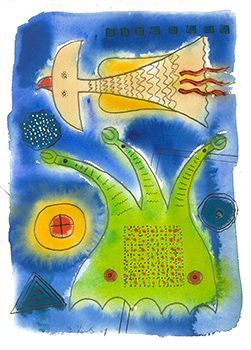
A painting by Motobu Kochi being kept at the AWI (untitled, ⒸManabu Kochi)
According to Kochi, the art currently being curated at the Galarie Claude Lemand are either (1) modern artists from the Arab world, (2) works commissioned by Lemand with the theme “Surreal depictions of birds,” or (3), the works of foreign artists living in Paris. As Kochi is the only artist that falls into both categories 2 and 3, his works were included in the gallery.
Kochi moved to Europe when he was 24 to pursue his dream of becoming a worldly artist.
Now that he has joined the ranks of internationally-recognized artists, he said with a twinkle in his eye, “There are no limits to dreams.
I want to keep expanding on my career.”
In order for the AWI to realize the Claude Lemand corner of the museum, they plan on converting part of the permanent exhibition floor.
From here on, Kochi will be donating 15-20 works to the AWI each year.
Kochi was also offered a commission to display his artwork in the new wing of the Hotel Palm Royal Naha in Naha, and has briefly returned to his home country for the first time in three years.
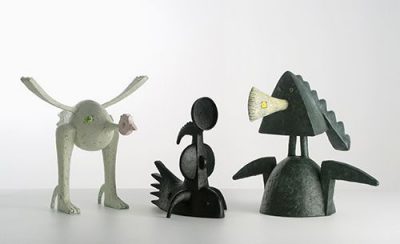
Sculptures at the AWI, part of Lemand’s “Surreal bird figures” series (ⒸManabu Kochi)
In June of last year he was diagnosed with cancer, and while he has been fighting the disease the part nine months with a new anti-cancer medication, he has recovered enough to travel home.
While he was sick, Kochi was encouraged by Lemand to draw every day, and even though there were days where the side effects of his medication made it hard to hold a pencil, he drew. He reflected, “It was good that I was able to unconsciously slip into my drawings.”
He said that he does not want to limit himself to just France and that he, “wants to raise his recognition globally,” and aims for bigger and better things.
(English translation by T&CT and Sam Grieb)
Go to Japanese
September 26, Ryukyu Shimpo
On September 25, the Okinawa Prefecture Department of Culture, Tourism and Sports announced the economic ripple effect of travel-related services and tourism for Fiscal Year (FY) 2017.
The effect was calculated based on travel and tourism expenditure, which was at 1,169,985,000,000-yen, a 14.2 percent increase compared to the previous results from FY2015.
This figure is a record high. The number of inbound tourists to Okinawa from in and out of the country continues to increase.
The lodging industry and eateries with strong ties to tourism mainly caused a big ripple effect on the prefecture’s economy.
780 Billion in Expenditure and an Employment Effect of 140 Thousand People
FY2017’s expenditure for travel services and tourism was 779.3 billion yen, a 12.7 percent increase compared to FY2015’s results.
Of this, expenditure of tourists from outside of Okinawa was 497.9 billion yen, while expenditure of foreign tourists was 200 billion yen.
Expenditure by local Okinawans traveling around Okinawa resulted in 81.4 billion yen.
The direct effect on the tourism industry inside of Okinawa was 691.2 billion yen, while 88.1 billion yen is estimated to have flowed out to other prefectures.
The primary ripple effect, such as increase in sales by industries related to tourism, was 314.4 billion yen.
The secondary ripple effect, such as revitalization of expenditure due to increased income, was 164.4 billion yen.
By industry, the lodging industry experienced an effect of 225.6 billion yen, while eateries experienced an effect of 187.7 billion yen, both showing high figures.
The employment inducement effect was 142,734 people, a 13.2 percent increase compared to FY2015.
It is clear that employment is also expanding thanks to an increase in tourists.
A representative from the above-mentioned department said, “We will continue to work on attracting tourists, and will promote programs to improve the expenditure per tourist and qualitatively change Okinawa’s tourism.”
(English translation by T&CT and Chelsea Ashimine)
Go to Japanese
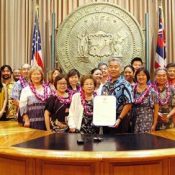
October 8, 2018 Ryukyu Shimpo
By Hanae Higa Gushiken
On September 27 (local time) in the Governor’s Ceremonial Room of the Hawaii State Capitol Building in Honolulu, the 70th anniversary of the happening known as Pigs from the Sea was commemorated.
Officials of the Hawaii United Okinawa Association (HUOA) attended the ceremony, as did descendents of the seven Okinawan men from Hawaii who set sail on the USS Owen to bring pigs to their kin in Okinawa in 1948. Representing these descendents, 3rd generation Okinawan Lilian Horio received the Pigs from the Sea Day Proclamation from Hawaii Governor David Ige.
It established September 27 as “Pigs from the Sea Day.”
During the Pacific War, Uchinanchu in Hawaii who served in the military or acted as interpreters in the Battle of Okinawa saw the food shortage being suffered back home.
As soon as they returned to Hawaii, they started relief work for Okinawa.
Hawaiian Uchinanchu came together and contributed 50,000 dollars toward the purchase of 550 pigs to send to Okinawa.
The pigs were delivered on September 27, 1948 at White Beach in Katsurenheshikiya, Uruma City, and distributed fairly.
After four years the pigs had been bred to produce 10,000 pigs.
This gesture greatly contributed to reviving Okinawa’s pig farming industry and eliminating the food shortage.
At the ceremony Governor Ige voiced his hope to pass down this story to coming generations, as he said it embodies the spirit of yuimaaru between Hawaii and Okinawa.
He also declared September 27 as Pigs from the Sea Day.
Translator’s note:
The aforementioned proclamation describes the practice of yuimaaru as “the act of being part of something greater than yourself, giving comfort to others with a warm heart.”
(English translation by T&CT and Erin Jones)
Go to Japanese

October 4, 2018 Ryukyu Shimpo
At 1:55 p.m. on October 4, Denny Tamaki, 58, held an inaugural press conference in the Prefectural Office’s special conference room. At the beginning of the press conference Tamaki made a statement as the new governor, “I will follow the wishes of the late governor Onaga to create a prosperous Okinawa with pride in the hearts of the prefectural people.
We will work to take on a democratic attitude that will guide us to solutions through dialogues with the central government.
We will also make full efforts to close Futenma Air Station as soon as possible, and stop construction of the new base in Henoko.
It is likely that Tamaki will be in a tough position in confrontations with the Japanese government, such as discussing the state taking measures against the revocation of Henoko land reclamation approval.
Tamaki emphasized that the prefectural government has the authority to revoke approval.
He said, “We urge the central government to comply with the decision to revoke [approval], and to use all tools available to spread the Okinawan peoples’ will to the international community.”
Meanwhile, he said, “I think it is necessary to start seeking windows for dialogue with Japan and the United States.”
He also stated his hope to seek an audience soon with the central government, in part through his inaugural address.
In addition to positioning countermeasures to child poverty as the most important task of the prefectural administration, Tamaki also voiced his wish to establish an independent economy.
He commented on the new Okinawan Promotion Plan 50 years after Okinawa’s reversion to Japan, saying, “We will lead the Japanese economy as a top runner in terms of scale and speed.”
(English translation by T&CT and Megumi Chibana)
Go to Japanese

October 4, 2018 Ryukyu Shimpo
On October 3 Denny Tamaki, after his election but prior to assuming office as governor of Okinawa, visited the sit-in at the front of the gate to Camp Schwab in Henoko, Nago City. As rain fell, about 130 gathered citizens smiled and congratulated him on his election.
Tamaki reiterated his determination to stop construction of the Henoko base along with those gathered.
At 4:00 p.m. citizens rushed up to a spot where performers were singing and dancing kachashi (an Okinawan folk dance), and waited for Tamaki to arrive.
After five minutes the car Tamaki was riding in stopped in front of the gate.
Citizens greeted him enthusiastically, shouting “Denny” and applauding.
Tamaki immediately rushed into the crowd and began shaking hands with and embracing citizens one by one.
He said, “Due to the result of the gubernatorial election, I will put all my efforts, my body and soul, into demonstrating that there is democracy here.”
The citizens simultaneously burst into applause as Tamaki voiced his determination.
Finally, those gathered held hands and formed a circle with Tamaki, shouting “Banzai” to celebrate their new governor. Even after Tamaki left the gate front, citizens sang and rejoiced.
Okinawa Peace Movement Center Chairman Hiroji Yamashiro said, “I am truly happy we have a new governor who supports the movement. I hope the prefectural government backs us [in our efforts].”
(English translation by T&CT and Erin Jones)
Go to Japanese
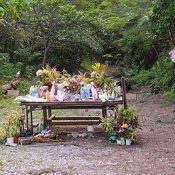
October 5, 2018 Ryukyu Shimpo
Kenneth Franklin Shinzato (formerly Gadson), the ex-Marine and U.S. military base worker convicted of the rape and murder of a 20-year-old Okinawan woman while she was out walking in central Honshima and given a life sentence which was upheld in an initial appeal, missed the October 4 deadline to make a final appeal, solidifying the life sentence at 12:00 a.m. October 5. According to sources, Shinzato had been meeting with his lawyer’s up through October 4, and had decided not to appeal.
According to the ruling, Shinzato struck the victim in the head with a rod, after which he killed her by repeatedly stabbing her with a knife near the road where he encountered her. After this violent crime had taken its tragic turn, Shinzato abandoned the body in the mountains near Onna.
The victim’s father commented, “This has left a big hole in our hearts that cannot be filled. From now on the thoughts of our daughter will always remain the same.”
(English translation by T&CT and Sam Grieb)
Go to Japanese


















 Webcam(Kokusai Street)
Webcam(Kokusai Street)


